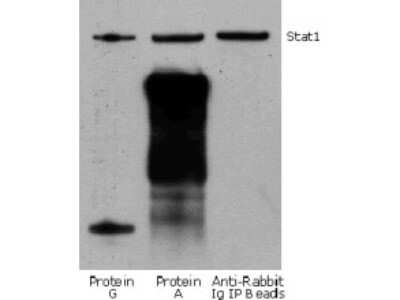Mouse Pure-Blot anti-Rabbit IgG (H+L) Secondary Antibody (eB182) [HRP]
Novus Biologicals, part of Bio-Techne | Catalog # NBP3-11668


Conjugate
Catalog #
Key Product Details
Species Reactivity
Rabbit
Applications
ELISA, Immunoprecipitation, Western Blot
Label
HRP
Antibody Source
Monoclonal Mouse IgG Clone # eB182
Concentration
Please see the vial label for concentration. If unlisted please contact technical services.
Product Specifications
Immunogen
Rabbit IgG
Clonality
Monoclonal
Host
Mouse
Isotype
IgG
Description
This secondary antibodye was prepared from tissue culture supernatant by Protein G affinity chromatography. Assay by immunoelectrophoresis resulted in a single precipitin arc against Anti-Rabbit Serum.
Store at -20C. This product is guaranteed for 6 months upon receipt, when handled and stored as instructed.
Store at -20C. This product is guaranteed for 6 months upon receipt, when handled and stored as instructed.
Scientific Data Images
Western Blot: Mouse Pure-Blot anti-Rabbit IgG (H+L) Secondary Antibody (eB182) [HRP] [NBP3-11668] - Jurkat cell lysate (0.5 ml of 1x10e7 cells/ml) was incubated with rabbit anti-human Stat1 and immunoprecipitated using Protein G, Protein A and Anti-Rabbit Ig IP Beads. Precipitate from 5x10e5 cells was subjected to electrophoresis, transferred to a PVDF membrane, and Western blotted with anti-Stat1 using Mouse Pure-Blot anti-Rabbit IgG Secondary antibody (eB182) [HRP].
Applications
Application
Recommended Usage
Western Blot
1:1000
Application Notes
This secondary antibody has been tested in ELISA, Western blot, and immunoprecipitation and may also be used for detection in immunoblotting assays that do not employ immunoprecipitation. Rabbit IgG Pure-Blot is provided as 1000X solution. To conserve reagent, we recommend incubating the blots from minigels in sealed bags (removing as much air as possible) with minimal volume (2-3 mLs). If used conservatively at 2.5 mLs/blot will yield enough reagent for 20 blots. Note that there are three key procedural considerations: 1. Protein A or G should not be used for the immunoprecipitation. Use of protein A or G beads with the rabbit Pure-Blot will result in contaminating bands. For immunoprecipitation, Anti-Rat IgG beads, or Anti-Rabbit IgG beads should be used for rat or rabbit immunoprecipitating antibodies, respectively. 2. Immunoprecipitate should be completely reduced. 3. BLOTTO/Milk should be used as the blocking protein for the immunoblot. All recommended dilutions for listed applications are intended as an initial recommendation, specific conditions for each protein and antibody combination should be specifically optimized by the end user.
ChIP, FISH, IF
ChIP, FISH, IF
Formulation, Preparation, and Storage
Purification
Protein G purified
Formulation
0.02 M Potassium Phosphate, 0.15 M Sodium Chloride, pH 7.2, 0.1 mg/ml Bovine Serum Albumin (BSA, IgG and Protease free), 50% (v/v) Glycerol
Preservative
ProClin 150
Concentration
Please see the vial label for concentration. If unlisted please contact technical services.
Shipping
The product is shipped with polar packs. Upon receipt, store it immediately at the temperature recommended below.
Stability & Storage
Store at -20C. Avoid freeze-thaw cycles.
Background: IgG (H+L)
The 4 IgG subclasses, sharing 95% amino acid identity, include IgG1, IgG2, IgG3, and IgG4 for humans and IgG1, IgG2a, IgG2b, and IgG3 for mice. The relative abundance of each human subclass is 60% for IgG1, 32% for IgG2, 4% for IgG3, and 4% for IgG4. In an IgG deficiency, there may be a shortage of one or more subclasses (4).
References
1. Painter RH. (1998) Encyclopedia of Immunology (Second Edition). Elsevier. 1208-1211
2. Chapter 9 - Antibodies. (2012) Immunology for Pharmacy. Mosby 70-78
3. Schroeder H, Cavacini, L. (2010) Structure and Function of Immunoglobulins. J Allergy Clin Immunol. 125(2 0 2): S41-S52. PMID: 20176268
4. Vidarsson G, Dekkers G, Rispens T. (2014) IgG subclasses and allotypes: from structure to effector functions. Front Immunol. 5:520. PMID: 25368619
Alternate Names
IP Detection Reagent
Additional IgG (H+L) Products
Product Specific Notices
This product is for research use only and is not approved for use in humans or in clinical diagnosis. Secondary Antibodies are guaranteed for 1 year from date of receipt.
